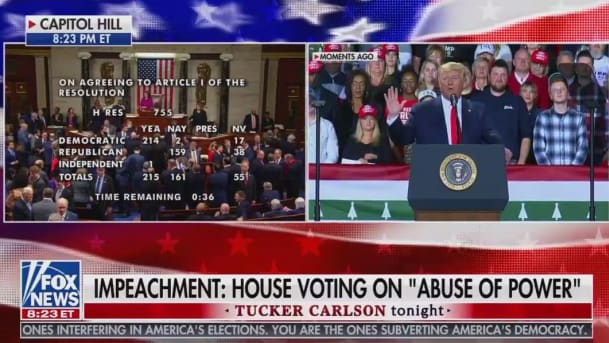Impeachment Coverage: A Screen Split Like the Nation
By • December 19, 2019 0 666

Years ago, when I was young, I was just beginning to think about history. It was something that happened a long time ago. I didn’t think much about impeachment.
I recall that I seemed to be aware that there had been an impeachment in the aftermath of the Civil War, and that Andrew Johnson — the man who was Abraham Lincoln’s vice president and became president — was impeached in 1868.
I can’t say I knew exactly what that meant. I heard it referenced as part of “Profiles in Courage,” a book by John F. Kennedy, who would become president a few years after it was published. One of the profiles was of a Republican named Edmund G. Ross, a congressman from Kansas, who cast the deciding vote to keep Johnson in office after he was impeached in the House and tried in the Senate.
The reference and the details at the time — around the presidential campaign of Kennedy versus Republican Richard Nixon, which Kennedy won by the thinnest of margins — escaped me then, and never came to mind at all for a number of years.
But impeachment is no longer an obscure reference; instead, it is an experience that I and many others have endured three times in our own lifetimes.
The very same Nixon, who had won a squeaker of an election over Hubert Humphrey in that wrenching year of 1968 and an astonishing and sweeping electoral victory over George McGovern in 1972, resigned his office in 1974 after articles of impeachment had been drawn up against him as part the “long, national nightmare” that was the Watergate scandal.
Two decades or so later, here we were again. I remember a Georgetowner headline: “The Scandal That Swallowed Washington.” This time, as Nixon noted himself, it was Bill Clinton’s turn in the barrel, the target of articles of impeachment drawn after he was accused of lying about an affair with an intern. Clinton was acquitted, and finished his second term of office with high approval ratings.
And here we are again.
“Trump Impeached” shouts the Washington Post’s top headline, in letters of a height usually reserved for election results, disasters and war. The subhead on the front page today, Dec. 19, 2019, reads: “President is Third in U.S. History to Face Senate Trial.”
Underneath are the voting results on the two articles of impeachment: 230-197 on Article 1, “Abuse of Power,” with President Donald Trump accused of using the power of the presidency for his own benefit; and 229-198 on Article 2, “Obstruction of Congress,” accusing him of blocking Congress’s investigation into his alleged wrongdoing.
The proceedings, the day, the events took up the entire front page, with three additional stories. Above the fold, a serious-faced but strangely glamorous Nancy Pelosi (D-California), House speaker, wielded her gavel in front of a United States flag. Below the fold, but dominant, was a portrait of President Trump pointing cheerfully to his followers, surrounded by a crowd of approximately 10,000 members of what’s often described as his “base,” at a rally in the electorally critical state of Michigan in the resonant city of Battle Creek. This, at the very time when Democrats and Republicans were loudly debating and preparing to vote on the two charges.
The juxtaposition captured a climactic point in a process that had begun three months ago, when a transcript of a phone call between the president and the newly elected president of Ukraine actively sparked the move toward impeachment. Pelosi, who had been reluctant to set out on that road, then became fully engaged.
The night of the vote felt weighted with the importance of a moment in history, fraught with the thought of an impending presidential election. The would-be impeachers felt compelled to treat this with solemnity and sadness, which was effective in its own way, especially the speech by House Majority Leader Steny Hoyer (D- Maryland), at once halting and senatorial in the Roman style. The Republicans responded with broadside after broadside, in the manner of Trump himself, filled with loud and lengthy hyperbole and disdain and dismissal — one going so far as to bring up Pontius Pilate.
The outcome was not in question, but even less so is the outcome in the Senate, should there be a trial. With the Republican Senate Majority Leader already pledging to coordinate the trial with the administration, an acquittal is almost certainly likely. The Democrats still want witnesses, and so are delaying the start of the trial.
What’s up in the air is the aftermath, and what’s becoming clearer than ever is just how divided the country is.
If you wanted a visual image of the United States in the year of impeachment and the years of President Donald Trump, it was the one that presented itself during the hearing and the voting. There was split-screen coverage by the networks: of the rally in Battle Creek and of the speeches, then the vote, on the floor of the House.
“Funny, this doesn’t feel like an impeachment,” the president said. And in truth, and in many ways, it didn’t and did.
It was the split screen itself which represented the reality of the times we live in.
That’s not going to change anytime soon — not in the aftermath of the impeachment trial, in whatever form it takes and with whatever result, not with the outcome of the Democratic presidential race, not even and perhaps especially with the outcome of the presidential election.
The election is only a little less than a year away. By then, the impeachment of President Donald Trump might seem like a long time ago, too.
But, for now, the split screen rules.

